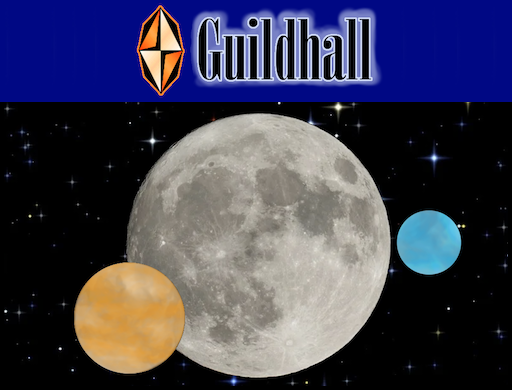




• Seahaven Towers
• Haniport Levee
• Angeline Crossing
• Delvenor Beacon
• Trek
• Dungeon
• Empire

• Terminus
• Grafiker
• Classic
• Contessa

• Paint
• Write
• Acoustiq
• Draw
• Filigree

• Tome
• Gamer
• Orbit
• Atlas
• Chronology

• Editor
• Player
• Reader
• Viewer
• Calc

Orbit, a Guildhall lore applet

So which came first, the story or the orbital mechanics applet? The story, of course. Scott H, that same fellow who worked with me on our version of Trek years ago, was the sort of RPG player who always wanted to know what was at the edge of the map, the map being the pride of this or any game master for having thought about the adventuring environment. That is, in fact, why there's a map for the Atlas applet to manage. Scott would always find a way to get off the map. So the map became larger, and of course that didn't work. Finally I drew out a map for the entire planet.
Naturally that didn't work either. What's up with these three moons, I recall he asked (and if he actually didn't, he should have). I had defined that the world of our gaming and storytelling adventures had three moons. The big white one was good old Luna, somehow moved from Earth. Of the other two, one was orange with an apparent diameter roughly one third that of Luna and an orbital period of five days. The small one, a bluish cyan color, had an apparent diameter roughly one quarter that of Luna and an orbital period of a fast three days. These are the full moons you see setting on the western horizon just before dawn if you win a game of Seahaven Towers, or that you see as horned moons in the western sky just after sunset if you win a game of Haniport Levee. So when Scott wanted to know about the moons, I said something like, "yeah, I've been wondering that myself. You're the physicist. You're going to help me figure it out."
He did. And that's where Orbit came from.
Scott used the information already defined, plus the additional clue that the world of our gaming was precisely Earth-like and its star precisely Sol-like, to calculate masses and velocities and starting positions for all three moons. We then coded the gravitational attractions between them to adjust those positions in step-wise fashion, using small increments of elapsed time. We got some pretty wild results while we were tuning Scott's algorithms, but eventually we got the orbits to settle down, stable for at least the 5000 years covered by the story.
These days the Orbit applet is in something of a state of disrepair, having been neglected while other Guildhall applets improved. But its time in the spotlight is coming again because its output is going to be important for my writing. But here's one fun fact. Our first effort started on a black and white Mac. It was very slow. We calculated it would take about 20 years to finish the orbital plots for the full 5000 year history. But Moore's Law had something to say about that, because processor speed kept doubling. The last time I ran Orbit I had to slow down the calculation to make the display interesting. It could calculate the full 5000 years in minutes. And when it finally comes back up, it should be substantially speedier than that. I'm thinking I might have to take account of a few more planets and moons in the same star system in order to get a better answer, and slow Orbit back down. For a while, at least.
Next Steps
- Get it running again